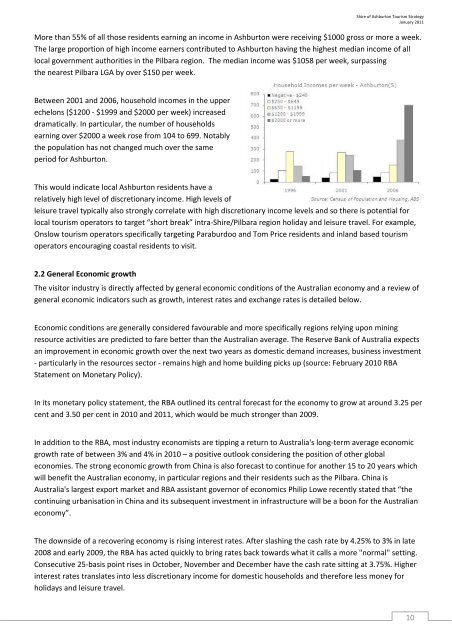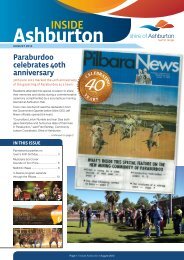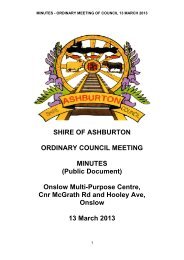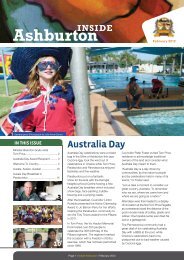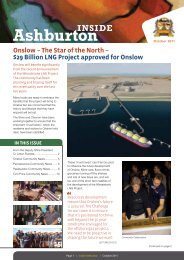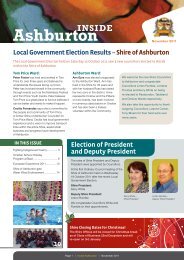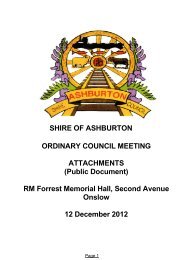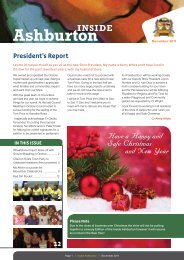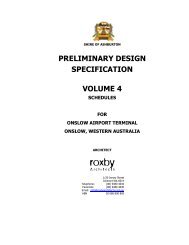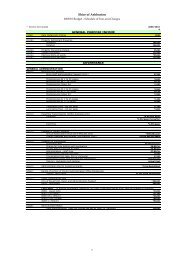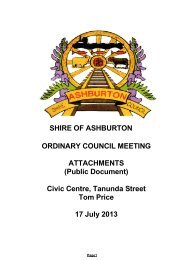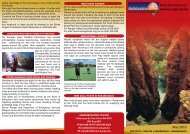Part 1 - Shire of Ashburton
Part 1 - Shire of Ashburton
Part 1 - Shire of Ashburton
You also want an ePaper? Increase the reach of your titles
YUMPU automatically turns print PDFs into web optimized ePapers that Google loves.
<strong>Shire</strong> <strong>of</strong> <strong>Ashburton</strong> Tourism Strategy<br />
January 2011<br />
More than 55% <strong>of</strong> all those residents earning an income in <strong>Ashburton</strong> were receiving $1000 gross or more a week.<br />
The large proportion <strong>of</strong> high income earners contributed to <strong>Ashburton</strong> having the highest median income <strong>of</strong> all<br />
local government authorities in the Pilbara region. The median income was $1058 per week, surpassing<br />
the nearest Pilbara LGA by over $150 per week.<br />
Between 2001 and 2006, household incomes in the upper<br />
echelons ($1200 ‐ $1999 and $2000 per week) increased<br />
dramatically. In particular, the number <strong>of</strong> households<br />
earning over $2000 a week rose from 104 to 699. Notably<br />
the population has not changed much over the same<br />
period for <strong>Ashburton</strong>.<br />
This would indicate local <strong>Ashburton</strong> residents have a<br />
relatively high level <strong>of</strong> discretionary income. High levels <strong>of</strong><br />
leisure travel typically also strongly correlate with high discretionary income levels and so there is potential for<br />
local tourism operators to target “short break” intra‐<strong>Shire</strong>/Pilbara region holiday and leisure travel. For example,<br />
Onslow tourism operators specifically targeting Paraburdoo and Tom Price residents and inland based tourism<br />
operators encouraging coastal residents to visit.<br />
2.2 General Economic growth<br />
The visitor industry is directly affected by general economic conditions <strong>of</strong> the Australian economy and a review <strong>of</strong><br />
general economic indicators such as growth, interest rates and exchange rates is detailed below.<br />
Economic conditions are generally considered favourable and more specifically regions relying upon mining<br />
resource activities are predicted to fare better than the Australian average. The Reserve Bank <strong>of</strong> Australia expects<br />
an improvement in economic growth over the next two years as domestic demand increases, business investment<br />
‐ particularly in the resources sector ‐ remains high and home building picks up (source: February 2010 RBA<br />
Statement on Monetary Policy).<br />
In its monetary policy statement, the RBA outlined its central forecast for the economy to grow at around 3.25 per<br />
cent and 3.50 per cent in 2010 and 2011, which would be much stronger than 2009.<br />
In addition to the RBA, most industry economists are tipping a return to Australia's long‐term average economic<br />
growth rate <strong>of</strong> between 3% and 4% in 2010 – a positive outlook considering the position <strong>of</strong> other global<br />
economies. The strong economic growth from China is also forecast to continue for another 15 to 20 years which<br />
will benefit the Australian economy, in particular regions and their residents such as the Pilbara. China is<br />
Australia's largest export market and RBA assistant governor <strong>of</strong> economics Philip Lowe recently stated that “the<br />
continuing urbanisation in China and its subsequent investment in infrastructure will be a boon for the Australian<br />
economy”.<br />
The downside <strong>of</strong> a recovering economy is rising interest rates. After slashing the cash rate by 4.25% to 3% in late<br />
2008 and early 2009, the RBA has acted quickly to bring rates back towards what it calls a more "normal" setting.<br />
Consecutive 25‐basis point rises in October, November and December have the cash rate sitting at 3.75%. Higher<br />
interest rates translates into less discretionary income for domestic households and therefore less money for<br />
holidays and leisure travel.<br />
10


